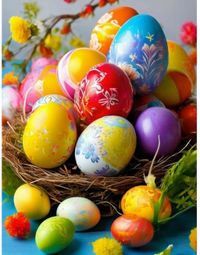Easter is a celebration steeped in history and tradition, marking the resurrection of Jesus Christ and symbolizing the arrival of spring across various cultures. While the essence of Easter remains the same, the ways in which it is celebrated differ significantly around the globe. From solemn religious observances to vibrant family gatherings, each country adds its unique flair to the festivities. This article explores the diverse Easter traditions, focusing on how different nations commemorate this significant holiday.
In Italy, Easter is marked by solemn religious services followed by a festive family lunch. The centerpiece of the meal is lamb, symbolizing purity and sacrifice. According to 24 Kanal, the Pope leads a traditional procession in Rome, reflecting the deep-rooted religious significance of the day. Families gather to share a meal that often includes various regional specialties, making it a time for unity and celebration.
In Greece, the night before Easter is filled with rituals as people head to churches with lamps to light them from the "Holy Fire." Fireworks light up the sky as families sit down for a festive meal that features a special Easter bread called tsoureki. Greeks also exchange red eggs, symbolizing the blood of Christ, adding a colorful and symbolic touch to their celebrations.
The United States presents a more secular face of Easter. While some still observe the religious aspects, many Americans associate the holiday with family fun and activities. The Easter Bunny has become a central figure, and one of the most beloved traditions is the Easter Egg Hunt, where children search for eggs hidden by the Bunny, often filled with candy or small surprises. This playful approach to Easter emphasizes family bonding and community spirit.
Australia offers a unique twist by substituting the Easter Bunny with the native bilby, a marsupial that raises awareness about wildlife conservation. Easter in Australia is a time for picnics and festivals, reflecting the country’s outdoor lifestyle and vibrant community spirit.
In Germany, the arrival of Easter is celebrated with the decoration of trees and bushes with colorful eggs, creating what are known as "Easter trees" or Ostereierbaum. The tradition of lighting Easter bonfires symbolizes the victory of light over darkness, a theme that resonates deeply during this festive season.
On the Philippines, Easter is marked by dramatic religious ceremonies, including theatrical reenactments of the last days of Jesus. In some regions, individuals even volunteer to experience Christ's suffering, adding a profound layer of devotion to the holiday.
Turning to Sweden, Easter traditions combine Christian customs with folk practices, symbolizing the arrival of spring after a long winter. Homes are decorated with colorful feathers and eggs, and children dress up as witches, a tradition rooted in historical witch trials. The week-long celebration includes various customs, such as the decoration of birch branches and the preparation of festive meals. Great Thursday, known as Skärtorsdag, is a day of purification, while Good Friday, or Långfredag, is traditionally a day of mourning.
In Sweden, the Easter festivities extend throughout the week, culminating in a midnight service that marks the resurrection of Christ. Easter Monday, or Annandag Påsk, is traditionally a day for young people to gather for parties, celebrating the end of the solemn days with joy and laughter.
In Daugavpils, Latvia, the city is adorned with festive decorations for Easter. On April 21, 2025, the second day of Easter will feature performances by various cultural groups, including Latvian, Latgalian, Russian, Polish, and Belarusian artists. The event promises a lively atmosphere with singing, dancing, and a festive fair, showcasing the rich cultural tapestry of the region.
In Jerusalem, Great Saturday is a significant day leading up to Easter, marked by solemn services and the anticipation of the Resurrection. The descent of the Holy Fire in the Church of the Holy Sepulchre symbolizes the triumph of life over death, a miracle that is celebrated annually. This day is a time for deep reflection and spiritual preparation, culminating in the joyous celebration of Easter Sunday.
As Ukrainians prepare for Easter, traditional meals are a focal point of the celebration. The Center for Public Health in Kharkiv has shared advice on how to enjoy the holiday while maintaining health. They recommend gradually transitioning from fasting to regular eating, emphasizing the importance of moderation, particularly with rich foods. The guidance includes choosing high-quality ingredients and incorporating plenty of vegetables and lean proteins into the festive meals.
In summary, Easter is a multifaceted holiday that transcends cultural boundaries, bringing together diverse traditions and practices. From solemn religious observances to vibrant family gatherings, the essence of Easter remains a celebration of renewal, hope, and the arrival of spring. As people around the world come together to mark this significant occasion, they carry forward the rich tapestry of customs that make Easter a truly global celebration.







